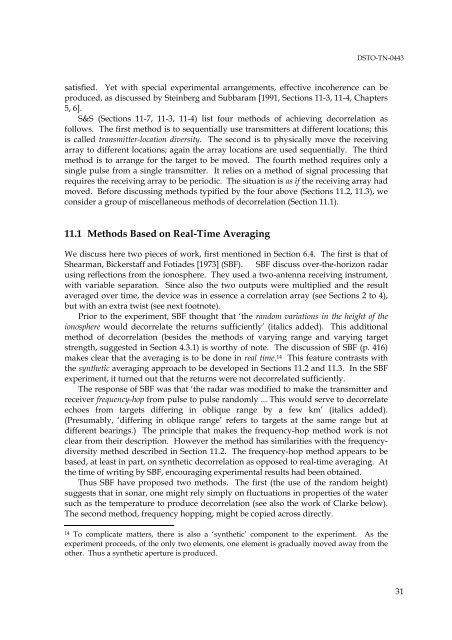Suitability of Correlation Arrays and Superresolution for Minehunting ...
Suitability of Correlation Arrays and Superresolution for Minehunting ...
Suitability of Correlation Arrays and Superresolution for Minehunting ...
You also want an ePaper? Increase the reach of your titles
YUMPU automatically turns print PDFs into web optimized ePapers that Google loves.
DSTO-TN-0443<br />
satisfied. Yet with special experimental arrangements, effective incoherence can be<br />
produced, as discussed by Steinberg <strong>and</strong> Subbaram [1991, Sections 11-3, 11-4, Chapters<br />
5, 6].<br />
S&S (Sections 11-7, 11-3, 11-4) list four methods <strong>of</strong> achieving decorrelation as<br />
follows. The first method is to sequentially use transmitters at different locations; this<br />
is called transmitter-location diversity. The second is to physically move the receiving<br />
array to different locations; again the array locations are used sequentially. The third<br />
method is to arrange <strong>for</strong> the target to be moved. The fourth method requires only a<br />
single pulse from a single transmitter. It relies on a method <strong>of</strong> signal processing that<br />
requires the receiving array to be periodic. The situation is as if the receiving array had<br />
moved. Be<strong>for</strong>e discussing methods typified by the four above (Sections 11.2, 11.3), we<br />
consider a group <strong>of</strong> miscellaneous methods <strong>of</strong> decorrelation (Section 11.1).<br />
11.1 Methods Based on Real-Time Averaging<br />
We discuss here two pieces <strong>of</strong> work, first mentioned in Section 6.4. The first is that <strong>of</strong><br />
Shearman, Bickerstaff <strong>and</strong> Fotiades [1973] (SBF). SBF discuss over-the-horizon radar<br />
using reflections from the ionosphere. They used a two-antenna receiving instrument,<br />
with variable separation. Since also the two outputs were multiplied <strong>and</strong> the result<br />
averaged over time, the device was in essence a correlation array (see Sections 2 to 4),<br />
but with an extra twist (see next footnote).<br />
Prior to the experiment, SBF thought that ‘the r<strong>and</strong>om variations in the height <strong>of</strong> the<br />
ionosphere would decorrelate the returns sufficiently’ (italics added). This additional<br />
method <strong>of</strong> decorrelation (besides the methods <strong>of</strong> varying range <strong>and</strong> varying target<br />
strength, suggested in Section 4.3.1) is worthy <strong>of</strong> note. The discussion <strong>of</strong> SBF (p. 416)<br />
makes clear that the averaging is to be done in real time. 14 This feature contrasts with<br />
the synthetic averaging approach to be developed in Sections 11.2 <strong>and</strong> 11.3. In the SBF<br />
experiment, it turned out that the returns were not decorrelated sufficiently.<br />
The response <strong>of</strong> SBF was that ‘the radar was modified to make the transmitter <strong>and</strong><br />
receiver frequency-hop from pulse to pulse r<strong>and</strong>omly ... This would serve to decorrelate<br />
echoes from targets differing in oblique range by a few km’ (italics added).<br />
(Presumably, ‘differing in oblique range’ refers to targets at the same range but at<br />
different bearings.) The principle that makes the frequency-hop method work is not<br />
clear from their description. However the method has similarities with the frequencydiversity<br />
method described in Section 11.2. The frequency-hop method appears to be<br />
based, at least in part, on synthetic decorrelation as opposed to real-time averaging. At<br />
the time <strong>of</strong> writing by SBF, encouraging experimental results had been obtained.<br />
Thus SBF have proposed two methods. The first (the use <strong>of</strong> the r<strong>and</strong>om height)<br />
suggests that in sonar, one might rely simply on fluctuations in properties <strong>of</strong> the water<br />
such as the temperature to produce decorrelation (see also the work <strong>of</strong> Clarke below).<br />
The second method, frequency hopping, might be copied across directly.<br />
14 To complicate matters, there is also a ‘synthetic’ component to the experiment. As the<br />
experiment proceeds, <strong>of</strong> the only two elements, one element is gradually moved away from the<br />
other. Thus a synthetic aperture is produced.<br />
31

















